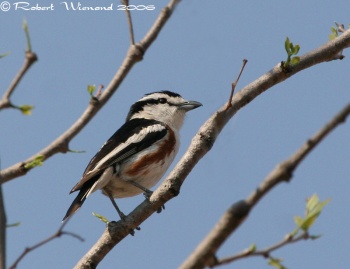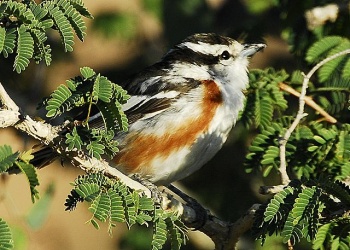- Nilaus afer
Identification
12–15 cm (4¾-6 in)
Male
- Mantle and central back rufous to buff, but see "Variation" below
- Mottled black and white rump
- White-tipped black tail
- Black crown
- White supercilium and forehead
- Black eyestripe
- Black wings with
- Buff to white shoulder stripe
- White underparts
- Rufous flanks
Female
- Duller and browner
- Streaked underparts
- Less rufous flanks
Juvenile
- Mottled brown, buff and white above
- Buff edged wings and tail
- White underparts with brown barring
Variation
The mantle and central back is black in some subspecies. The shoulder stripe varies from white to buff. The underside is white, to pale yellowish in some areas. The flank stripe is chestnut in some areas, white in others.
Distribution

Photo © by safariranger
Shingwedzi Camp, Kruger National Park, South Africa, November 2006
Widespread in sub-saharan Africa
Western Africa: Mauritania, Senegal, The Gambia, Guinea-Bissau, Guinea, Mali, Sierra Leone, Ivory Coast, Burkina Faso, Ghana, Togo, Benin, Nigeria, Niger, Chad, Cameroon, Central African Republic, Equatorial Guinea, Gabon, DRC and Angola
Eastern Africa: Sudan, South Sudan, Eritrea, Ethiopia, Somalia, Kenya, Uganda, Rwanda, Burundi, Tanzania, Zambia, Mozambique and Malawi
Southern Africa: Namibia, Botswana, Zimbabwe, South Africa and eSwatini (not found in the southern-most part of South Africa)
Taxonomy
Nilaus is a monospecific genus. Its relationships are unclear, and in the past it has been variously treated in Laniidae, Prionopidae, Muscicapidae and Platysteiridae, before finding its current placement in Malaconotidae[1].
Subspecies
Nine subspecies are currently accepted[1][2]:
- N. l. afer: Senegal to the Sudan, Eritrea and Ethiopia
- N. l. camerunensis: Southern Cameroon and Central African Republic to eastern Democratic Republic of Congo
- N. l. minor: Southeastern South Sudan, southeastern Ethiopia, central and southern Somalia, northern and eastern Kenya, and northeastern Tanzania
- N. l. massaicus: South-western Kenya to northern Tanzania, Rwanda and eastern Democratic Republic of Congo
- N. l. nigritemporalis: Eastern Angola, south-eastern Democratic Republic of Congo, Tanzania, Zambia, Malawi, northern Mozambique
- N. l. brubru: Southern Angola to north-central South Africa
- N. l. solivagus: eSwatini, Zimbabwe and inland parts of eastern South Africa and southern Mozambique
- N. l. affinis: Central highlands of western Angola and adjacent southern Democratic Republic of Congo
- N. l. miombensis: Coastal parts of eastern South Africa and Mozambique (Sol do Save region)
An extra subspecies N. l. hilgerti in eastern Ethiopia[3] is treated as a synonym of N. l. minor by other authorities[4].
Habitat
Open broad-leaved woodland, and acacia savanna. Generally found in the canopy.
Behaviour
Diet
The diet consists of insects, including caterpillars, moths, beetles, ants, flies and grasshoppers.
Breeding
They build a well camouflaged cup nest using twigs, grass and spider webs, decorated with lichens. The two whitish, greenish or greyish eggs have grey or brown blotches. They are incubated by both sexes for about 19 days; the young fledge in 22 days and are dependent on their parents for about eight weeks.
Brubrus are known to destroy their own nests when disturbed.
Vocalisation
Call: A repeated "brrr brrr ..." (hence the common name); similar to a ringing telephone.
References
- Del Hoyo, J, A Elliott, and D Christie, eds. 2009. Handbook of the Birds of the World. Volume 14: Bush-shrikes to Old World Sparrows. Barcelona: Lynx Edicions. ISBN 978-8496553507
- Clements, J. F., T. S. Schulenberg, M. J. Iliff, D. Roberson, T. A. Fredericks, B. L. Sullivan, and C. L. Wood. 2017. The eBird/Clements checklist of birds of the world: v2017, with updates to August 2017. Downloaded from http://www.birds.cornell.edu/clementschecklist/download/
- Gill, F and D Donsker (Eds). 2014. IOC World Bird Names (version 4.4). Available at http://www.worldbirdnames.org/.
- Avibase
- Handbook of the Birds of the World Alive (retrieved December 2014)
- Wikipedia
- BF Member observations
Recommended Citation
- BirdForum Opus contributors. (2025) Brubru. In: BirdForum, the forum for wild birds and birding. Retrieved 9 May 2025 from https://www.birdforum.net/opus/Brubru
External Links
GSearch checked for 2020 platform.1






